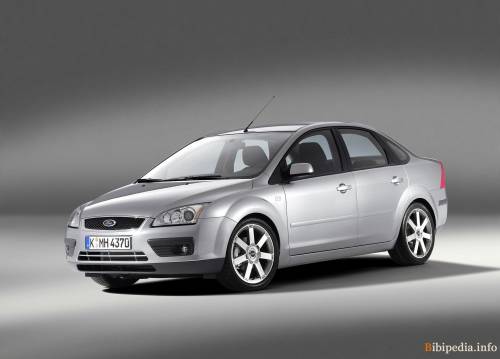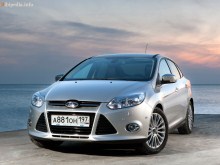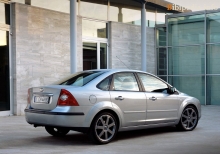Characteristics Ford Focus (sedan)
Focus sedan characteristics since 2010
| Modification | Power, kW (lp)/about | Fuel consumption (average), l/100 km | Weight (mass), kg |
|---|---|---|---|
| 1.4 MT | (80)/5700 | 6.6 | 1272 |
| 1.6 at | (100)/6000 | 7.7 | 1286 |
| 1.6 mt | (115)/6000 | 6.4 | 1296 |
| 1.8 mt | (125)/6000 | 7 | - |
| 1.8 TDCI MT | (115)/3700 | 5.3 | 1431 |
| 2.0 AT | (145)/6000 | 8 | - |
| 2.0 mt | (145)/6000 | 7.1 | 1364 |
Focus 4 doors 2008 - 2010 characteristics
| Modification | Power, kW (lp)/about | Fuel consumption (average), l/100 km | Weight (mass), kg |
|---|---|---|---|
| 1.6 TDCI (100 hp) | 74(100)/4000 | 4.5 | 1277 |
| 1.6 TDCI (109 hp) | 80(109)/4000 | 4.5 | 1285 |
| 2.0 TDCI | 100(136)/4000 | 5.6 | 1335 |
| 1.4 16V | 59(80)/5700 | 6.6 | 1170 |
| 1.6 16V | 74(100)/5500 | 6.7 | 1170 |
| 2.0 16V | 107(145)/6000 | 7.1 | 1241 |
Focus 4 doors 2005 - 2007 characteristics
| Modification | Power, kW (lp)/about | Fuel consumption (average), l/100 km | Weight (mass), kg |
|---|---|---|---|
| 1.6 TDCI (109 hp) | 80(109)/4000 | 4.8 | 1820 |
| 1.6 TDCI (90 hp) | 66(90)/4000 | 4.7 | 1815 |
| 1.8 TDCI | 85(115)/3700 | 5.3 | 1448 |
| 2.0 TDCI | 100(136)/4000 | 5.6 | 1330 |
| 1.8 | 92(125)/6000 | 7.4 | 1330 |
| 1.4 | 59(80)/5700 | 6.6 | 1735 |
| 1.6 (116 hp) | 85(116)/6000 | 6.4 | 1765 |
| 1.6 (80 hp) | 74(101)/6000 | 6.7 | 1750 |
| 2 | 107(146)/6000 | 7.1 | 1775 |
Focus 4 doors 2001 - 2005 characteristics
| Modification | Power, kW (lp)/about | Fuel consumption (average), l/100 km | Weight (mass), kg |
|---|---|---|---|
| 1.8 TDCI (101 hp) | 74(101)/3850 | 5.2 | 1321 |
| 1.8 TDCI (115 hp) | 85(115)/3800 | 5.4 | 1328 |
| 1.8 TDDI (75 hp) | 55(75)/4000 | 5.1 | 1321 |
| 1.8 TDDI (90 hp) | 66(90)/4000 | 5.4 | 1321 |
| 1.4 | 55(75)/5000 | 6.6 | 1202 |
| 1.6 | 74(100)/6000 | 6.8 | 1206 |
| 1.8 | 85(115)/5500 | 7.5 | 1234 |
| 2 | 96(130)/5500 | 8.6 | 1276 |
Focus 4 doors 1999 - 2001 characteristics
| Modification | Power, kW (lp)/about | Fuel consumption (average), l/100 km | Weight (mass), kg |
|---|---|---|---|
| 1.8 TDCI | 85(115)/3800 | 5.5 | - |
| 1.8 TDDI | 66(90)/4000 | 5.4 | 1205 |
| 1.6i | 71(100)/6000 | 7 | 1091 |
| 1.8i | 84(115)/5750 | 7.5 | 1143 |
| 2.0i | 96(130)/5750 | 5.3 | 1160 |
Opinion about Ford Focus 2005

The predecessor of FF2 gained wide recognition in our country. And although Korean cars were sold better, the FF is a very popular model. Thanks to domestic assembly options, cars were available at the middle class price. For a more demanding audience, Euro version was offered: Jia, Hassal, Edien and Titanium in a hurry. The costs of that is also quite acceptable. The manufacturer recommends visiting the service every 20,000 km. Although the mechanics, due to the harsh climate, are advised to do this as often as possible.
The ratio of price-quality conquered domestic motorists. Of course, there are more maneuverable models, but in any case they are inferior to the FF in terms of quality of chassis and more expensive in operation. The focus of the second generation is designed for a mass consumer. For this, he is very grateful.
Naturally, there are disadvantages. Soundproofing is not at height, in particular, a faint noise of the wheel arches. But this is a lack of almost all Odnoklassniki FF2. Perhaps in other brands the seat is more comfortable (Opel Astra). However, the difference in the price between them is simply huge.
We offer a wide selection of used tricks. They have disadvantages, but there are not many of them.
The body and chassis
FF is proposed in three versions: station wagon, sedan and hatchback. The last two are widespread. I like the sedan more.
LKP leaves much to be desired: it is easy to put a scratch. Japanese competitors in this regard lose even more. Chromely spare parts in our conditions fade. Rust can appear on the thresholds and arches.
The chassis is quite reliable. In the bulkhead, the need arises no earlier than 90,000 km. Only the front supporting bearings are summed up, which are at first noisy, and then 60,000 km break. The rear will last several tens of thousands of km longer. Often the bearings of shock absorber racks and rear levers are out of order. In the case of disadvantages, this is all. I repeat, the price-quality ratio is perfect.
When purchasing a used car, no doubt, attention should be paid first of all to its condition, then to the number of options. However, I do not advise you to take Ambient's configuration, even if the machine is in perfect condition. The fact is that in this version there is no ABS, without which braking is simply terrible even on good asphalt.
Motors and transmission
The most popular engines with a volume of 1.6 liters (old with 100 hp and a new 115-horsepower with gas distribution adjustment) are most popular. The latter is quite powerful and, in my opinion, this is the most acceptable option. However, if a phase regulator is out of order, the power will drop noticeably, and it will take from 10,000 rubles to the bulkhead.
A weak motor with a volume of 1.4 liters is suitable only for an inexperienced driver. The belt of the gas distribution mechanism on these engines does not last longer than 160,000 km. I do not advise you to establish a new one, due to special specifics, only specialists can do this.
For versions with more powerful engines, you will have to give more. But the drive of the gas distribution mechanism and the belt tensioner on them are more durable. The deficiency of a 1.8-liter engine is floating idle.
Please note that only two engines go with the automatic transmission: a 1.6-liter 100-horsepower and more powerful 2-liter (for more new cars).
The ST version proposes a Duratec motor with a volume of 2.5 liters and 5 cylinders with manual transmission. It accelerates to 250 km/h, acceleration from scratch to hundreds in 6.7 seconds. It is designed for dashings who can’t afford a sports car. I do not advise buying such a used model, since usually such cars do not spare.
Focus engines are quite capricious to fuel. If you fill in a low -grade, there will be problems with the launch. A controller of the position of the electric carssel may break. The crankshaft sensor in turn is durable. The oil proceeds due to wear of the camshaft oil seals. Dust under the hood is a common occurrence. The engine compartment clogs.
Automatic transmission, like manual transmission usually does not cause trouble. One minus - with a sudden reverse, the back gear wedges. This is due to the uninchronization of the device. Some in this case recommend a couple of seconds to crush the clutch pedal.
Other problems
There have been cases of barracks of the GUR on new cars. The sign - the steering wheel becomes much more tight. In this situation, you need to see the fluid level and check the gur’s tube, it often breaks off. Sometimes a reverse tube hose is torn.
In addition, an electrician is often junk. Often rot the numbers backlighting. Another drawback is a defect in the glass-glass cleaners: do not touch the glass. Therefore, the glass is often dirty in front of the passenger.
Price
The used cars in an adequate state cost an average of 300 thousand rubles.
Conclusion
The best choice of all classmates. Good quality for an acceptable price. Inexpensive in maintenance. The presence of only small minuses. I don’t know whether this is a disadvantage or advantage: prevalence on our roads.





